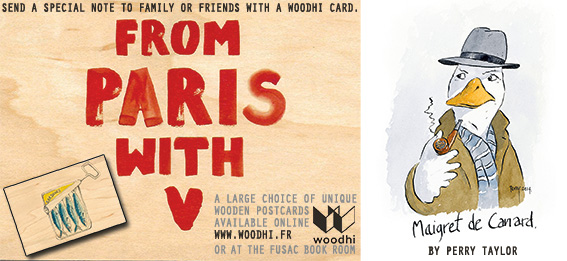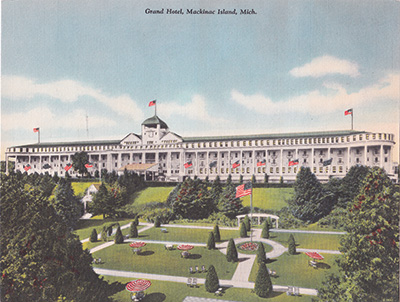The Power of a Postcard – make an impact
I’ve received postcards from my parents when they travel for many years. I’ve kept nearly all of them in a file and some day when they can no longer travel it will become a set of reminiscences to look at with them. The power of a postcard picture and small bits of information on the weather or activities will bring their trips back to life and lead us on to various and sundry conversations. I also have a collection of my-grandmother-in-law’s postcards which she sent in the 1940s and 50s when traveling in the United States. Some were picked up along the way at the Howard Johnson’s Motor Inn or others in National Parks.
I know from being both the sender and receiver of postcards how the power of a postcard is to bring joy. That’s why when we created Bill & Rosa’s Book Room we put in a POP desk dedicated to what we call the Power of a Postcard. Time and time again we have found that taking a few minutes to hand write a postcard to someone makes a huge impact. Whether your send it from your home town or an exotic place you are visiting doesn’t matter. It’s the thought that counts. We’ve sent them to clients, friends, family. When we see the recipient again they ALWAYS thank us profusely – even months later. They were touched and delighted we had thought of them. They might be inspired to visit the place of origin of the card. They often keep them. Our optician has it behind his reception desk. A friend has it in her kitchen. Postcards cost very little in time and money and have a HUGE impact. Visit the Book Room and discover the power of a postcard too. We have a unique set of cards on hand. Wooden postcards by Woodhi, funny cards from Perry Taylor, plus stamps and pens too – everything you need to make someone’s day. Now read on for postcard history.
Not only will postcards make the recipient happy but did you know that writing by hand is good exercise for your brain? https://elemental.medium.com/bring-back-handwriting-its-good-for-your-brain-fe22fe6c81d2?gi=a4ba75c49e66
A little postcard history
The first officially allowed postcard was in the Austro-Hungarian Empire in 1869. It was a simple “correspondence card” with the destination indicated on one side and the message on the other. It became quite popular for correspondence from the front during the Franco-Prussian war. The earliest known picture postcard was a hand-painted design on card in London in 1840. However it is unknown who had the idea of a mass produced image and when or where the first one was created. Postcards have not been archived in national data banks like stamps or books and governments had strong control over what could be mailed. We do know that in the 1870s you could purchase mailing cards decorated with sentimental or patriotic images, but they weren’t quite postcards. By the time of the universal exposition of 1889 in Paris the postcard was the new must-have souvenir. 300,000 copies of a card with an image of the Eiffel Tower at the Paris exposition were sold thus popularizing the use and collection of picture postcards which commemorate a specific event or location. The Chicago World’s Fair, 1893, solidified the tendency and official postcards were printed for that event.
Each year in France 250 million postcards are sold, most of them in the summer time as many of them are vacation souvenirs. The apex of postcards was probably between 1900 and 1914 where 800 million cards were sent. At the time there were 6 postal pickups per day and people sent cards like today we send a text message – to say hello or invite some one for dinner the next day. Sweden sent more than forty-eight million postcards in 1904 and the population was only 5 million people at the time. There you see the power of a postcard. The French continue to like them. Sébastien Lapaque, who wrote the “Theorie de la carte postale” says “The postcard has the same force today as yesterday: it is within everyone’s reach. The use of the postcard is neither elitist nor popular. Besides, we cannot determine the nature of people who write postcards, or define an age group. A postcard is something that is unintimidating, it is familiar, friendly and fun and then the back, image, is a gift in itself and not expensive! We keep it, we display it at home. » The picture on the front of the card advertises the act of travel, and the postmark on the back certifies it as authentic. In an era before the availability of inexpensive snapshot cameras, postcards became a powerful medium for evoking various corners of the world and how one might interact with them. Postcard artists and photographers presented idealized visions of how a place should be seen, so much so that when snapshots gradually replaced postcards tourist photographs tended to mimic the visual clichés of postcard images (and they still do). The modest utilitarian object became a cultural vector bringing its various publicity messages right into our homes.
The types of images and methods for printing have changed over time according to different fashions. But Henry Condamine founder of the Editor Groupe, the leading card and wrapping editors in Europe, says that there are 3 categories that have stayed the same over time: monuments, nature and people especially folklore subjects.
White border postcards in response to the war-time shortages of ink.
Mid-century « linen » postcards used newer printing processes on inexpensive card stock with a high rag content, and were then finished with a pattern which resembled the texture of linen. The rag content in the card stock allowed a much more colorful and vibrant image to be printed than the earlier « white border » style. Even though the images on linen cards were based on photographs, they contained much handwork of the artists who brought them into production. There is of course nothing new in this; what is notable is that they were to be the last postcards to show any touch of the human hand on them.
The last and current postcard era is the « chrome » era, a shortened version of Photochrom. These types of cards were developed in about 1939 but did not begin to dominate until about 1950 (partially due to war shortages during WWII). The images on these cards are generally based on color photographs, and are readily identified by the glossy appearance of the paper’s coating.
Today it is the big tourist images that grace the most often purchased postcards. The old-style village images are no longer produced. Animals and even insects used to be popular at the beginning of the century and they still are. One might say that sending cats, dogs, horses and bunnies to deliver cute messages is an eternal and nearly universal human trait. And remember pinups? Alas they are pretty much gone, replaced by more raunchy sex images with coy texts. But of course Sunsets are ever popular since the advent of color printing.
Other spots in Paris beyond Bill and Rosa’s Book Room that have unique post cards are
- Buci News
- Bring France Home – historic cards
- Brentano’s
- The marché du livre ancien et des vieux papiers in the Parc Georges Brassens every weekend offers vintage postcards which also make a great souvenir of your time in France or wall decorations
Look for ones Made in France and printed on paper from sustainable forests to enhance the Power of a Postcard.
Two museums talk about postcards:
Le Musée de la Poste – in Paris and the Musée de la Carte Postale in Antibes which propose history and guided visits for collectors and the curious.







